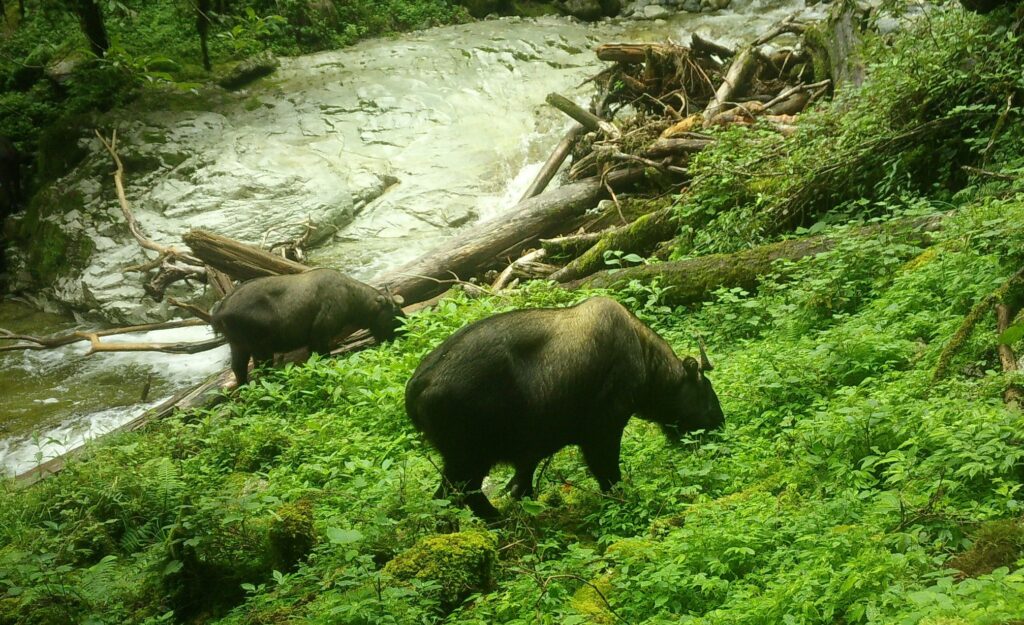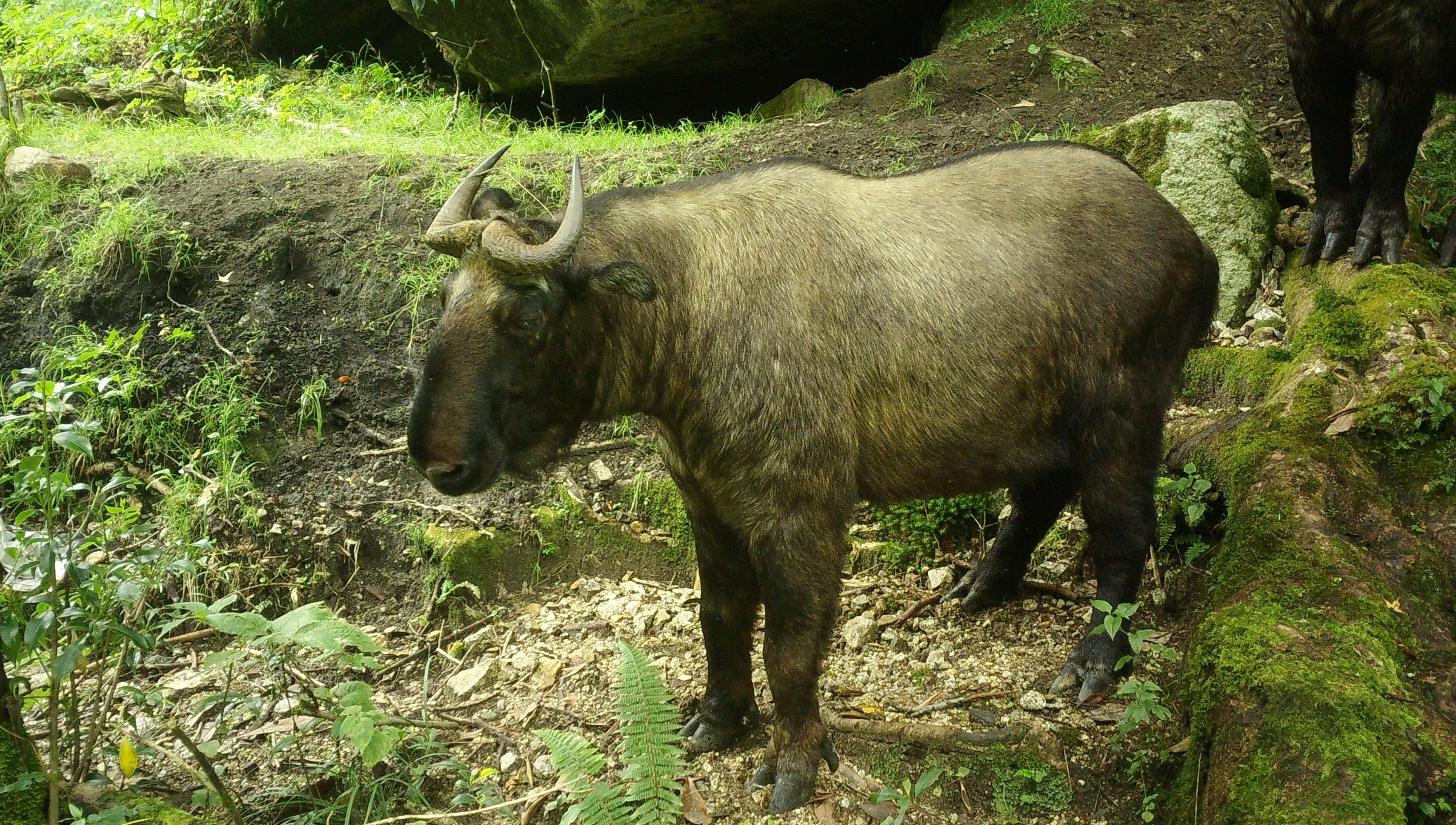Recent camera trap footage from the Kamlang Tiger Reserve and Wildlife Sanctuary in Lohit and Anjaw districts of Arunachal Pradesh have revealed thriving populations of the Mishmi Takin (Budorcas taxicolor taxicolour), a rare and vulnerable subspecies of the goat-antelope.
The footage captured herds ranging from solitary individuals to groups of up to 30, a promising indicator of the species’ stability within this protected habitat. These recordings mark a significant step forward in documenting and conserving the Mishmi Takin, a species known for its elusiveness.
The visuals were recorded during August and September this year.

The Mishmi Takin, distinguished by its robust build, golden-brown coat, and distinctive facial features, is native to the Eastern Himalayas, including the Mishmi Hills of Arunachal Pradesh, Bhutan, and parts of China. It inhabits steep, mountainous terrain at altitudes of 2,000 to 4,500 meters and is adept at navigating dense forests and rocky outcrops.
As herbivores, the animals play a vital ecological role by grazing on grasses, shrubs, bamboo, and other vegetation, which helps regulate plant growth and promote seed dispersal.
Range Forest Officer of Kamlang Tiger Reserve, Bunty Tao said: “Their presence reflects the health of the ecosystem,”.
“The species contributes to maintaining biodiversity and shaping the structure of the forest,” he added.
Habitat and Ecology in Kamlang
The Kamlang Tiger Reserve provides an ideal habitat for the Mishmi Takin, offering dense temperate forests, alpine meadows, and bamboo thickets.
The Kamlang Tiger Reserve, spanning over 783 square kilometres, is a sanctuary for diverse flora and fauna. It is home to the four big cats—tiger, leopard, clouded leopard, and snow leopard—and other rare species like the red panda and white-bellied heron.
These habitats not only shield the species from predators but also provide a year-round food supply. During colder months, the animals often descend to lower altitudes, utilizing the sanctuary’s unique terrain.
Tao said that the region’s diverse flora and fauna, coupled with its geographical peculiarity, create a thriving environment for species like the Mishmi Takin.
Alongside them, Kamlang is home to rare wildlife such as the red panda, white-bellied heron, and four species of big cats, including the snow leopard.

Conservation Status and Challenges
Listed under Schedule I of the Indian Wildlife Protection Act, 1972, the Mishmi Takin enjoys the highest level of legal protection in India. It is also classified as Vulnerable by the International Union for Conservation of Nature (IUCN). Despite this, the species faces threats from habitat loss, climate change, poaching, and human encroachment.
Tao acknowledged these challenges but expressed optimism about the future.
“Every year, we deploy trail cameras to document the wildlife in the reserve, and the consistent sightings of Mishmi Takin in herds suggest that our conservation measures are working. However, protecting their habitat remains a critical priority,” he said.
Conservation Efforts in Action
The Kamlang Tiger Reserve has taken proactive measures to conserve the Mishmi Takin and its habitat. These include annual deployment of trail cameras has been crucial in understanding wildlife behaviour and population trends.
Despite its protected status, the Mishmi Takin faces challenges from human encroachment and illegal hunting. Increased vigilance and community involvement have helped reduce poaching incidents in the reserve.
Local communities are also being engaged through awareness programs to foster coexistence with wildlife.
Tao said that the official conservation strategy relies on a combination of technology, community participation, and strict law enforcement.
Behaviour and Social Structure
Mishmi Takins are diurnal and tend to be most active in the early morning and late afternoon. They are social animals, typically forming matriarchal herds of related females, their young, and a few males.
Males often live alone or in small bachelor groups, joining larger herds only during the autumn mating season.
Female Mishmi Takins give birth in secluded areas after a gestation period of about 240-260 days, ensuring the safety of their young.
Biodiversity Hotspot
The Kamlang Tiger Reserve and Wildlife Sanctuary stands out not only for its Mishmi Takin population but also for its role in preserving one of the richest biodiversity zones in the Eastern Himalayas. Along with iconic species such as the red panda and clouded leopard, the reserve is home to numerous endemic plants and animals.
The Way Forward
Looking ahead, the Kamlang Tiger Reserve is focusing on expanding its research and conservation programs. These include enhanced use of technology for wildlife monitoring, developing sustainable ecotourism initiatives to highlight the sanctuary’s unique biodiversity, and strengthening collaborations with local communities to ensure long-term conservation success.
Also read: Arunachal sets sight on Olympics with new sports initiative





